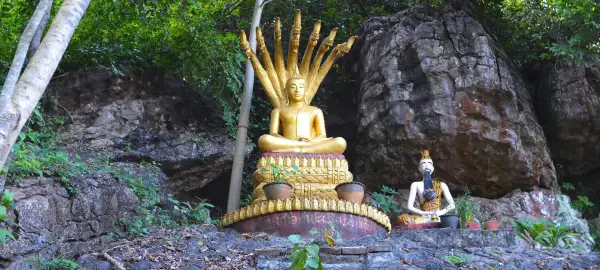PLEASE NOTE: Our hours of operation on Friday 12 Dec 25 will be 10:00-17:00 PST due to a staff function. Book online anytime via this website; email sales@adventures-abroad.com to reach out.
Small Group Experiential Travel
Tour Code
LA1 When To Go
Mar, Nov Start
Luang Prabang (LPQ) End
Viangchan (VTE) Countries Visited (1)
Laos Overnight In (4)
Luang Prabang,...More > Activity Level
2 - Moderate? Tour Type
Cultural? - Overview
- Info & Inclusions
- Itinerary
- Map & Hotels
- Photos
- Dates & Prices
Highlights
- Max Group Size 18
- Explore the enchanting city of Luang Prabang, a UNESCO World Heritage site
- Wander through ancient temples adorned with intricate mosaics
- Hike through lush rainforests on the Bolaven Plateau
- Witness the awe-inspiring Khone Phapheng Falls, Southeast Asia's largest waterfall
- Visit the magnificent Pha That Luang stupa in Vientiane
- Immerse yourself in Laotian culture and history on this unforgettable journey.
- Singles friendly (view options for single travellers)
Description
Imagine journeying through Laos, a land of ancient temples, lush rainforests, and peaceful villages. This captivating adventure invites you to explore the soul of Laos, from the enchanting city of Luang Prabang to the tranquil beauty of Khong Island. Wander through ancient temples, hike through rainforests, and immerse yourself in Laotian culture. Visit the magnificent Pha That Luang stupa in Vientiane and discover the rich tapestry of Laotian history. This unforgettable journey promises a unique blend of cultural immersion, historical exploration, and breathtaking natural beauty.
Price Includes
- Full-time Tour Leader services
- Breakfast and dinner daily (see detailed itinerary for daily meal plan).
- All transport, accommodation, sightseeing and entrance fees for sites noted as 'visited' in the detailed itinerary.
- Gratuities for drivers, restaurant staff, porters, local guides.
- Airport transfers for land & air customers and for early arriving/late departing land & air customers who book their extra hotel nights through us.
Exclusions
- International airfare to/from the tour.
- Tour Leader gratuities, most lunches, drinks, personal items (phone, laundry, etc), domestic and international (if applicable) air taxes, visa fees, and any excursions referenced as 'optional'.
- Airport transfers for Land Only customers.
- Optional trip cancellation insurance.
Trip Info
- Seasonality and Weather:
Our October departure is just outside of the coolest time of year and the end of rainy season in Laos; it still rains now and then, but not too much to seriously affect our trip. The scenery is green and lush, and the weather is generally pleasant at this time of year. We will likely still experience some heat, but our October visit avoids the possibility of being caught in cold weather outbreaks that tend to descend from the north Nov-Jan, which can uncomfortably chilly.
Our March date also skips the cool and cloudy winter period and the heat of summer, which begins in May. March may be somewhat less green overall as things begin to dry out; that said, it's an interesting time as it coincides with the harvest of various crops.
Overall you should prepare for warm-hot, sometimes sticky weather with the possibility of rain and some chilly nights/mornings in a few locales. - Transport and Travel Conditions:
Land transport throughout will be by private air-conditioned bus. Most of the driving days are not long, but progress can be slow due to the nature of the roads and traffic. Internal flights via scheduled regional carriers.
The tour is not strenuous though it is busy; you must be steady on your feet and be able to endure some heat and some long days. We have numerous walking tours and visit several sites that are LARGE with steps and uneven surfaces. Our level "2" rating for this tour refers to the ambitious itinerary, full travel days, early starts, walking tours, uneven surfaces, and the possibility of heat in some locales.
Porters are available at hotels but you must be able to manage with your baggage at airports. age with your baggage at airports.
Am I suitable for this tour? Please refer to our self-assessment form - Activity Level: 2
These are particularly busy tours that feature a lot of moving around, sometimes by train and short journeys on local transport. Walking tours of towns and cities are leisurely but you should be prepared to be on your feet for several hours. Some of our cultural trips that occur at high altitude and/or require greater independence with baggage handling (at hotels, airports, train stations) also fall into this category.
To learn more about the Activity levels, please visit our tour styles page. - Accommodation:
Hotels used on tour are modern, comfortable, well-located, air-conditioned, 3-4 star properties with en suite bath/toilet. Some are resort-style boutique properties with plenty of charm and atmosphere. Single rooms are limited and possibly smaller than twins. Laundry facilities are available at most hotels for a reasonable price.
Click on "Map & Hotels" tab elsewhere on this page for more info. - Staff and Support:
Tour Leader, driver, local step-on guides in various locales. - Group Size:
Maximum 18 plus Tour Leader
View / Print Itinerary
- Day 1:Arrival in Luang PrabangArrival in Luang Prabang, the spiritual heart of Laos and a UNESCO World Heritage Site since 1995. Nestled at the confluence of the Mekong and Nam Khan rivers, this former royal capital has preserved its architectural heritage better than perhaps any other city in Southeast Asia. French colonial villas, Buddhist temples, and traditional Lao houses line streets that have changed remarkably little over the past century.
This evening we meet our Tour Leader and fellow travellers for a welcome dinner.
Overnight in Luang Prabang.
Included Meal(s): Dinner, if required - Day 2:Luang Prabang: Town TouringToday we explore Luang Prabang, beginning with the city's remarkable history. In the 14th century, Fa Ngum established Luang Prabang as the capital of Lan Xang, the "Kingdom of a Million Elephants." The city's history extends even further back — by this time, Luang Prabang had already served as the seat of local kingdoms for 600 years. Legend holds that two hermits chose the site, originally known as Xieng Thong, meaning "Copper Tree City."
We begin with an orientation walk along the main street, where colonial-era buildings now house shops, cafés, and art galleries. The compact town centre lends itself to exploration on foot, allowing us to absorb the atmosphere and discover details that would be missed from a vehicle.
Later we climb Phu Si Hill for panoramic views across the city. From this vantage point, the cruciform layout of the former Royal Palace becomes visible below, along with the Mekong River and the mountains beyond. The hill rises 100 metres (328 feet) above the surrounding town and hosts several small shrines along its paths, including Wat Chom Si at the summit, whose golden spire catches the late afternoon sun.
The city's designation as a World Heritage Site recognizes not just individual monuments, but the remarkably intact urban landscape — a rare surviving example of the fusion between traditional Lao architecture and European colonial building styles from the 19th and 20th centuries.
Overnight in Luang Prabang.
Included Meal(s): Breakfast and Dinner - Day 3:Luang Prabang AreaAn early departure takes us to the Mekong River, where we board a long covered boat equipped with comfortable cushions, life jackets, and facilities for the two-hour journey to Pak Ou Caves. The boat journey itself rewards as much as the destination — we pass riverside villages, fishermen casting nets, and mountains rising from both banks.
The Pak Ou Caves comprise two caverns carved into limestone cliffs at the point where the Nam Ou River joins the Mekong. The site has been sacred for centuries, even predating Buddhism, when local people worshipped spirits believed to inhabit the caves. Today thousands of Buddha images fill every available nook and cranny, ranging from tiny 8-centimetre (3-inch) figures to statues nearly 3 metres (9 feet) tall.
The lower cave, Tham Ting, contains over 4,000 images accumulated over hundreds of years as pilgrims brought offerings. The upper cave, Tham Phum, extends deeper into the cliff, where Buddha images are placed far back in the darkness — a torch proves useful here. The figures represent various styles and periods, creating an unintended museum of Lao Buddhist art.
We return to Luang Prabang and visit the Royal Palace, now a museum containing collections spanning the 15th to 17th centuries. The last member of Lao royalty to live here was Crown Prince Sisavang Vatthana, son of King Sisavang Vong. The private chapel houses the Phra Bang Buddha, the sacred gold image that gives the city its current name. Cast from 90% pure gold and weighing approximately 50 kilograms (110 pounds), the statue stands in the Abhayamudra pose, symbolizing the dispelling of fear.
We conclude with visits to several temples. Wat Xieng Thong, built in 1560, represents the pinnacle of Luang Prabang temple architecture with its gracefully curved, multi-tiered roofs and richly decorated wooden interior. Wat Mai displays classic design elements, while Wat Wisunalat contains wooden Buddha statues dating back 400 years.
Overnight in Luang Prabang.
Included Meal(s): Breakfast and Dinner - Day 4:Luang Prabang - Train to Vientiane - Fly to PakseThis morning we journey through Laos aboard the China-Laos Railway, connecting Luang Prabang to Vientiane in approximately two hours. This railway, which opened in 2021, represents a significant infrastructure development for landlocked Laos, linking the country to China's broader rail network. The train offers comfortable seating with charging facilities as we travel through mountainous terrain.
Departing Luang Prabang, we witness the changing landscape — lush river valleys, traditional villages, and limestone karst formations. The route includes a stop at Vang Vieng, known for its dramatic scenery. As we approach Vientiane, views open across the Mekong River valley and the surrounding countryside.
Arriving in Vientiane (the capital, also spelled Viangchan in older texts), we connect with our onward flight to Pakse in southern Laos, arriving in time for dinner.
NOTE: Due to train schedules that are subject to change with little notice, we may accomplish this journey by air.
Overnight in Pakse.
Included Meal(s): Breakfast and Dinner - Day 5:Pakse Market - Vat Phou Temple - Don KhongPakse, situated in southern Laos near the Thai border, served as the capital of the Kingdom of Champasak until the early 20th century. This morning we visit Pakse's market, where vendors sell fresh produce, fragrant spices, local handicrafts, and Lao coffee — the region is renowned for coffee cultivation on the nearby Bolaven Plateau.
We continue to Vat Phou, one of Southeast Asia's most significant archaeological sites and a UNESCO World Heritage Site since 2001. Built between the late 10th and early 11th centuries, this pre-Angkorian temple complex predates the great monuments of Angkor by nearly a century. The Khmer builders chose this location for its sacred mountain, Phu Kao, which dominates the site and was believed to house powerful spirits.
The temple's design integrates architecture with the natural landscape in ways that influenced later Angkorian construction. A ceremonial causeway leads from ancient barays (reservoirs) through successive terraces to the sanctuary at the mountain's base. The stone carvings — particularly those depicting Hindu deities and mythological scenes — show remarkable depth and detail despite centuries of weathering. The site originally served as a Hindu temple dedicated to Shiva before its conversion to Buddhist use.
After our visit, we continue south to Si Phan Don, meaning "Four Thousand Islands" in Lao. This 50-kilometre (31-mile) stretch of the Mekong River fragments into countless channels and islands, roughly half of which become submerged during the annual floods. The landscape here differs markedly from northern Laos — flatter, more tropical, with the Mekong reaching its widest point before continuing into Cambodia.
Overnight on Don Khong (Khong Island).
Included Meal(s): Breakfast and Dinner - Day 6:Phan Don - Phapheng Waterfalls - PakseToday we embark on a boat excursion through the islands of Si Phan Don, beginning with a visit to Khone Island. During the French colonial period (1893-1945), France attempted to establish a trade route along the entire Mekong River. The Khone Falls blocked river traffic, so the French built Laos's only railway — a 7-kilometre (4-mile) line with a pier, station, hospital, and maritime office. We visit these remnants, now slowly being reclaimed by vegetation, which offer insight into colonial ambitions and the challenges the Mekong presented to navigation.
We continue to Li Phi Waterfall, known locally as Taat Somhamit. The Lao nickname translates as "Corridor of the Devil" or "Spirit Trap" — local belief held that the turbulent waters captured malevolent spirits, preventing them from traveling further downstream. The falls create a dramatic display where the Mekong drops through a series of rocky channels.
In the afternoon we travel by road to Khone Phapheng Falls, the widest waterfall in Southeast Asia. During peak flow, the falls measure 10.8 kilometres (6.7 miles) wide, with water dropping 21 metres (69 feet) in a series of cascades. The volume and power of the Mekong here explain why this barrier prevented French colonial dreams of continuous river navigation from China to the sea.
We return to Pakse, concluding our exploration of southern Laos's river landscapes.
Overnight in Pakse.
Included Meal(s): Breakfast and Dinner - Day 7:Pakse: Bolaven Plateau - Fly to VientianeThis morning we drive from Pakse to the Bolaven Plateau, a highland region rising 1000-1350 metres (3,280-4,430 feet) above sea level. The elevation creates a cooler climate and higher rainfall than the surrounding lowlands, making the plateau ideal for agriculture. French colonists introduced coffee here in the early 20th century, and today the Bolaven Plateau produces some of Southeast Asia's finest arabica and robusta beans.
Our route passes through countryside where ethnic minority villages — including Alak, Katu, and Suay communities — maintain traditional ways of life. Rice paddies give way to banana plantations and coffee estates as we climb toward the plateau. The volcanic soil, combined with the climate, creates conditions that coffee growers prize.
We visit Tad Fane Waterfall, one of the plateau's most impressive natural features. Twin streams of water plunge 120 metres (394 feet) into a narrow gorge surrounded by protected forest. A short walk through the forest brings us to viewpoints overlooking the falls and the surrounding landscape of coffee plantations and jungle.
At a local coffee plantation, we learn about cultivation, harvesting, and processing methods. The Bolaven's coffee cherries are typically hand-picked at peak ripeness, then processed using traditional methods that have changed little over decades. We sample the finished product — the region's coffee is known for its rich flavour and low acidity.
As we explore the plateau, we may visit additional waterfalls and remote villages, depending on road conditions and time. The plateau's relative isolation has helped preserve both its natural environment and traditional cultures.
In the late afternoon we return to Pakse for our short flight back to Vientiane (aka Viangchan), Laos's capital city.
Overnight in Vientiane.
Included Meal(s): Breakfast and Dinner - Day 8:Vientiane TouringToday's sightseeing takes us to Pha That Luang, a gold-covered large Buddhist stupa in the centre of the city. Since its initial establishment, suggested to be in the 3rd century, the stupa has undergone several reconstructions as recently as the 1930s due to foreign invasions of the area. It is generally regarded as the most important national monument in Laos and a national symbol. The architecture of the building includes many references to Lao culture and identity, and so has become a symbol of Lao nationalism.
We also stop at Haw Pha Kaew, a temple now serving as a museum of religious artifacts. It was a royal family temple for worshiping the Jade Buddha and holding religious ceremonies. The magnificent temple is three storeys high with gorgeous palace hall and huge Buddha altar. However, in 1779 A.D, the King of Siam with his army invaded the city and looted the Jade Buddha as well. Many precious collections can be seen there, such as the gold throne, the wood carving of high quality and statues of Buddha of various sizes and shapes.
We also travel to Buddha Park (aka Xieng Khuan), a famous sculpture park with more than 200 religious statues including a huge 40-metre high reclining Buddha image. It was built in 1958 by Luang Pu Bunleua Sulilat, a monk who studied both Buddhism and Hinduism. This explains why his park is full not only of Buddha images but also of Hindu gods as well as demons and animals from both beliefs.
This evening you may wish to take a stroll along the river front and take in the giant sprawling market, with its instantly recognizable red-roofed stalls and crowds of people who come to snap up a bargain or just soak up the laidback Mekong atmosphere.
PLEASE NOTE that some or all of today's sightseeing and your departure tomorrow may be managed and guided by one of our local associates. This is due to the fact that your Tour Leader may be leaving early today with travellers who have chosen to extend their tour to include Vietnam.
Overnight in Vientiane.
Included Meal(s): Breakfast and Dinner - Day 9:DepartureDeparture from Vientiane.
BON VOYAGE!!
Included Meal(s): Breakfast
Regions Visited: Southeast Asia
Countries Visited: Laos
Countries Visited: Laos
*The red tour trail on the map does not represent the actual travel path.

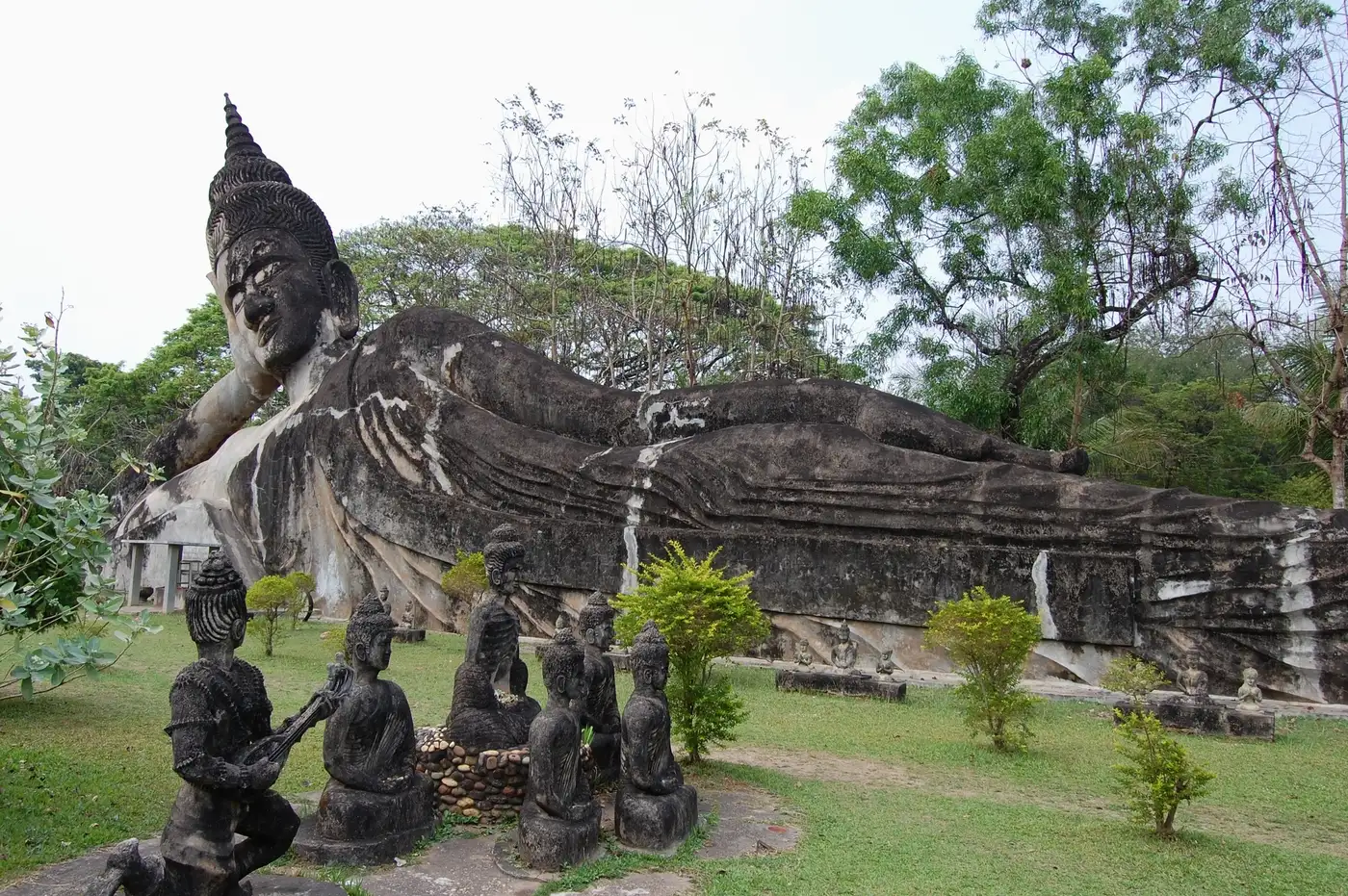
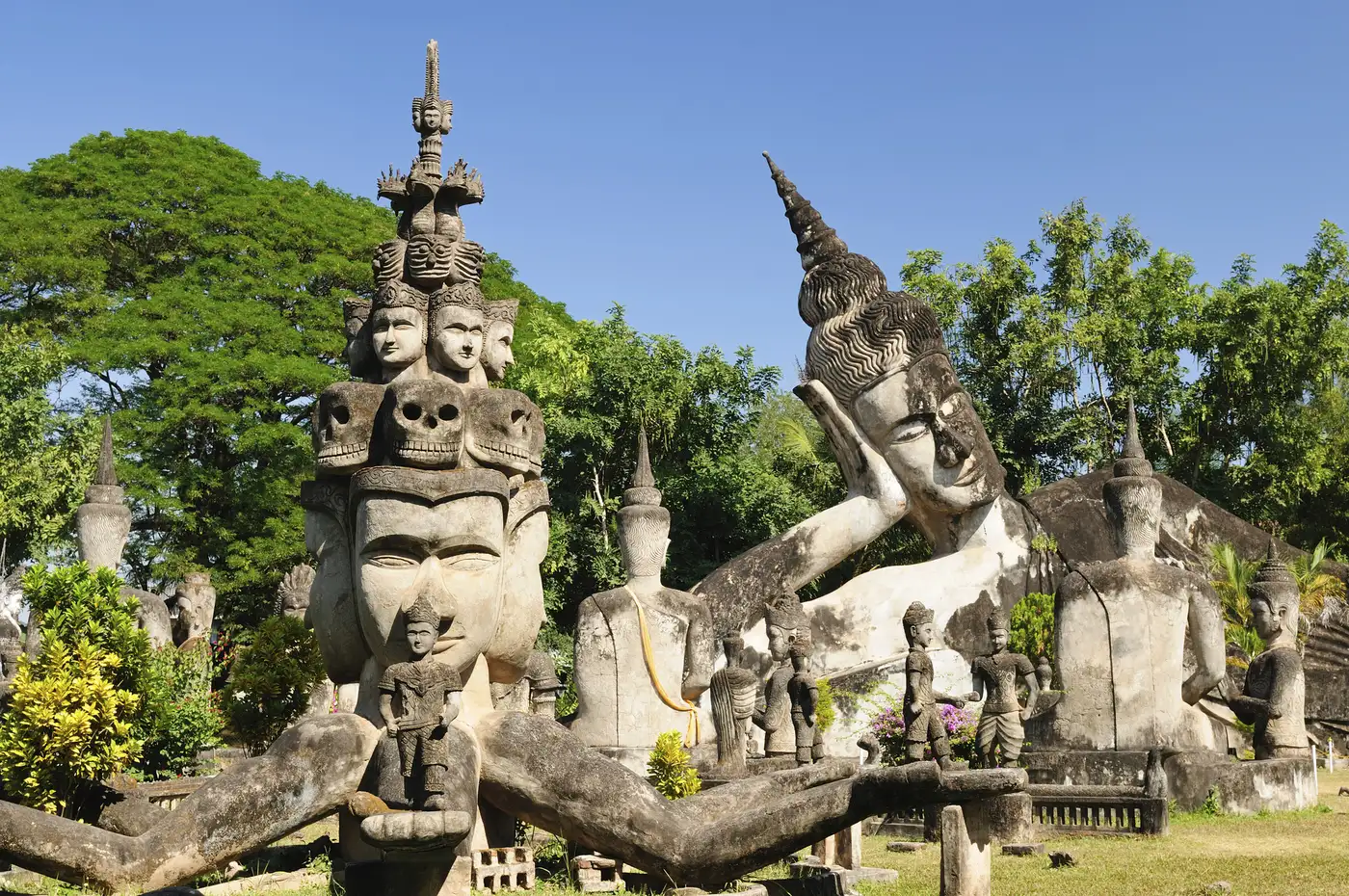

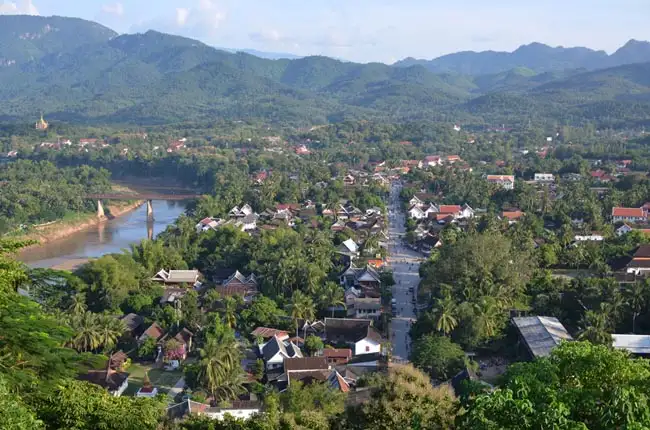
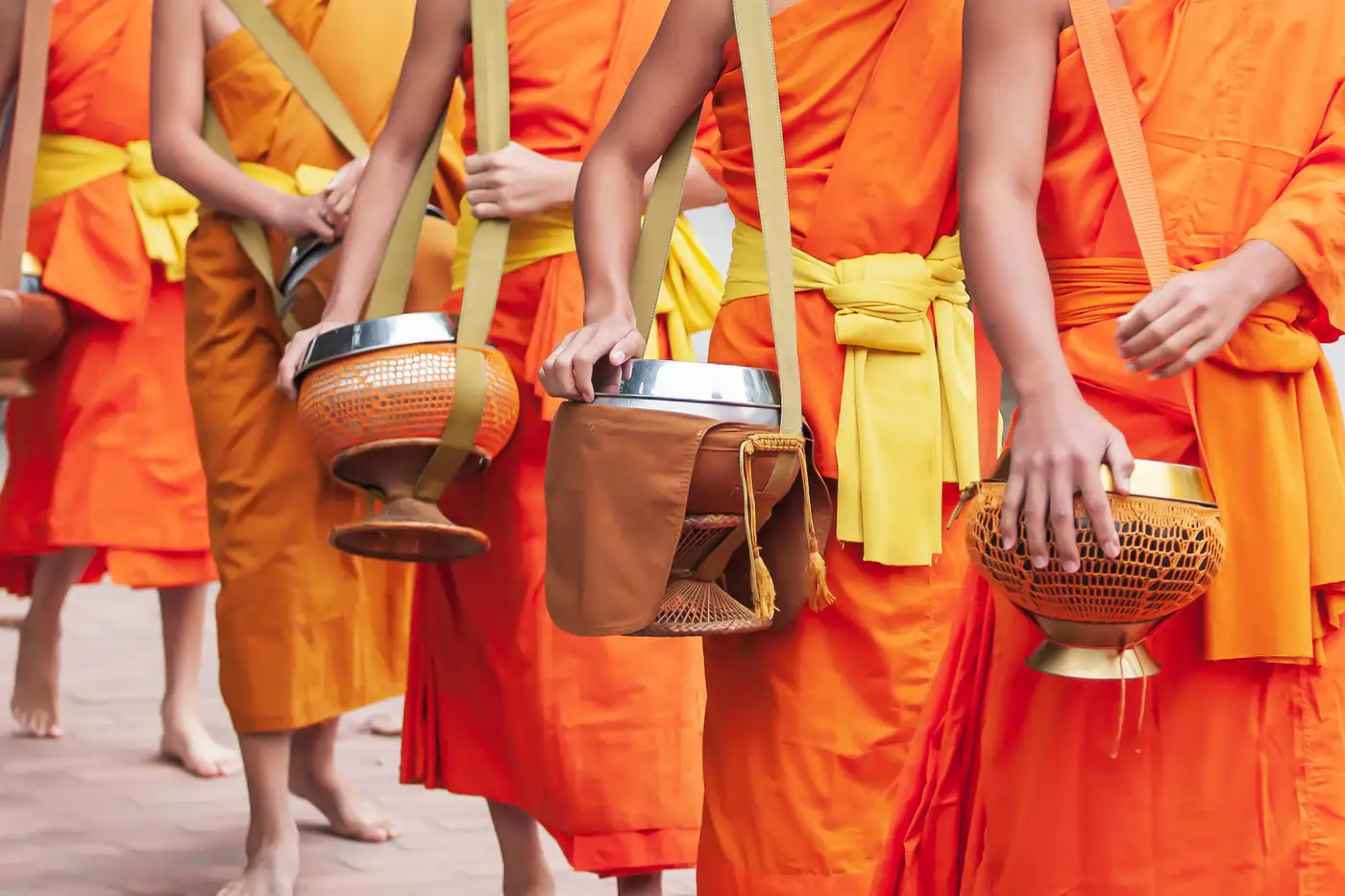
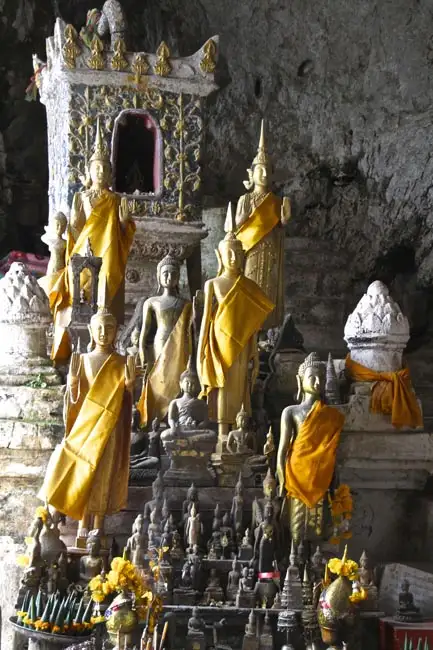

Excellent
Overall Rating
4.7
Extend Your Trip
This tour is part of a series that can be upgraded to make for a longer trip.
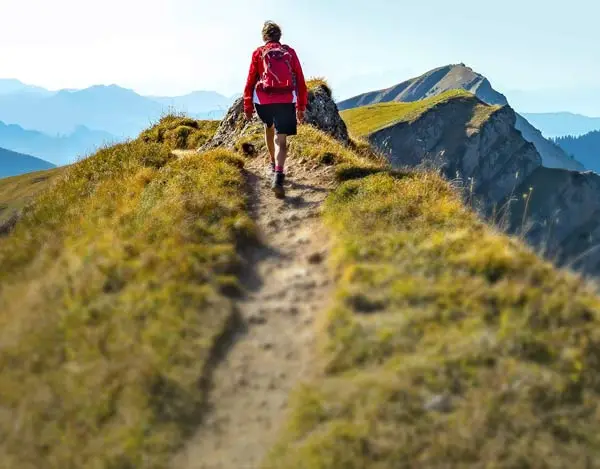
Fast and easy
Book This Tour
Book your unforgettable adventure today! For any questions or advice, don't hesitate to contact us.
Have questions?
1-800-665-3998
- Final payment: Due 90 days prior to departure.
- Deposit: A non-refundable $500 USD Deposit is required at booking.
- Internal Flight Taxes: An extra $53 USD applies for taxes and fees on tour flights. The internal airfares are included, but taxes are listed separately as they may change. Exceptions are noted in Red.
- Optional Single Supplement: $670 USD (number of singles limited).
(View options forsingle travellers) - Transfering Tour or Date: Transferring to another tour or tour date is only permissible outside of 120 days prior to departure and is subject to a $100 USD change fee.
(Read our cancellation policy)
Choose your departure date:
Prices below are per person, twin-sharing costs in US Dollars (USD). Pricing does not include airfare to/from the tour and any applicable taxes.
Prices below are per person, twin-sharing costs in US Dollars (USD). Pricing does not include airfare to/from the tour and any applicable taxes.
Frequently Asked Questions
- What is the maximum number of participants on a trip?Most of our tours carry a maximum of 18 participants; some tours (ie hiking tours) top out at 16. In the event that we do not achieve our minimum complement by our 90-day deadline, we may offer group members the option of paying a "small-group surcharge" as an alternative to cancellation. If all group members agree, we will confirm the trip at existing numbers; this surcharge is refundable in the event that we ultimately achieve our regular minimum. If the small group surcharge is not accepted, we will offer a refund of your deposit or a different trip of your choice.
- Can I extend my tour either at the beginning or end? What about stopovers?Yes, you can extend your tour either at the beginning or the end and we can book accommodation in our tour hotel. Stopovers are often permitted, depending on air routing. Stopovers usually carry a "stopover" fee levied by the airline.
- How do I make a reservation? How and when do I pay?The easiest way to make a reservation is via our website; during office hours, you are also more than welcome to contact us by telephone.
A non-refundable deposit is payable at the time of booking; if a reservation is made within 90 days, full payment is required. Some trips require a larger deposit. If international airline bookings require a non-refundable payment in order to secure space or the lowest available fare, we will require an increase in deposit equal to the cost of the ticket(s).
Early enrolment is always encouraged as group size is limited and some trips require greater preparation time.
Once we have received your deposit, we will confirm your space and send you a confirmation package containing your trip itinerary, any visa/travel permit related documents, invoice, clothing and equipment recommendations, general information on your destination(s), and forms for you to complete, sign and return to us. Your air e-tickets (if applicable), final hotel list, final trip itinerary, and instructions on how to join your tour, will be sent approximately 2-3 weeks prior to departure. - What about cancellations, refunds, and transfers?Please review our cancellation policy page for details.
- I am a single who prefers my own room. What is a single supplement?All of our tours have a single supplement for those who want to be guaranteed their own room at each location.
This supplement is a reflection of the fact that most hotels around the world do not discount the regular twin-share rate for a room by 50% for only one person occupying a room. Most hotels will give a break on the price, but usually in the range of 25-30% of the twin-share rate. This difference, multiplied by each night, amounts to the single supplement.
The conventional amount can also vary from country to country and some destinations are more expensive than others for single occupancy. In order to be "single friendly," the supplements we apply are not a profit centre for us and we do our best to keep them as reasonable as possible.
On most tours we limit the number of singles available, not to be punitive, but rather because many hotels allow for only a limited number of singles; some smaller hotels at remote locations also have a limited number of single rooms available.
Please note that most single rooms around the world are smaller than twin-share rooms and will likely have only one bed. - Do you have a shared accommodation program?Yes! If you are single traveller and are willing to share, we will do our best to pair you with a same-gender roommate. Please note that should we fail to pair you, we will absorb the single supplement fee and you will default to a single room at no extra charge.
